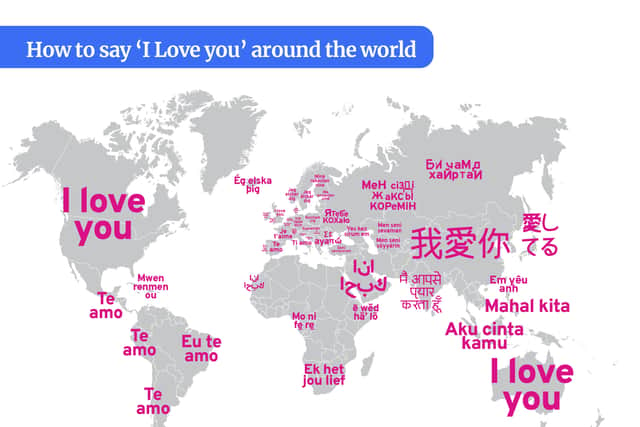Valentine’s Day: how to say ‘I love you’ around the world - traditions, history and dates
and live on Freeview channel 276
Valentine’s Day is celebrated annually on 14 February and originated as a Christian Feast Day. Initially, it honoured early Christian martyrs named Saint Valentine, but through folk traditions, it has gained popularity as a mark of celebration of romance and love.
Although labelled as Valentine’s Day, there are several Valentines connected to the date, with an early tradition telling of Saint Valentine, who was arrested for ministering to Christians, restored sight to the blind daughter of his jailer. Later, in the 18th Century, this was elaborated to claim he wrote the jailer’s daughter a letter signed "Your Valentine" as a farewell before his execution.
Advertisement
Hide AdAdvertisement
Hide AdIn the 14th and 15th centuries, the day became associated with romantic love - combined with the new trend of courtly love. In England - by the 18th Century - the date grew into an occasion where couples expressed their love for each other by presenting flowers, offering confectionery, and sending greeting cards, known as "valentines".
With Valentine’s Day coming up, how do people around the world say "I love you" and what are the traditions around it?


How to say "I love you" in different languages
English - I Love You
In the UK, the USA, New Zealand, Australia, Canada, and other English-speaking countries, “I love you” is a profession of adoration.
On Valentine’s Day, English-speaking countries tend to celebrate romance on 14 February by exchanging gifts and going out for romantic dinners.
Advertisement
Hide AdAdvertisement
Hide AdPopular gifts include chocolates, cards, jewellery, and flowers, usually roses - which have a long association with romance, making them a popular choice for Valentine’s Day gifts.
The tradition of giving roses on Valentine’s Day is said to have originated in ancient Rome, where roses were used in religious and secular celebrations. The red rose was especially significant, as it was believed to symbolise love and desire.
Spanish: Te quiero or Te amo
Preply says te quiero and te amo are both ways to express romantic love. However, te quiero is more frequently used in everyday conversation and considered to be less intense or stronger than te amo, which is used on more special occasions or when expressing deep feelings of love.
Argentina has two celebrations of love: Valentine’s day and ‘Semana de la Dulzura’ (Sweetness Week). This runs for a whole week in July and candy is given to them in exchange for a kiss.
Advertisement
Hide AdAdvertisement
Hide AdIn Guatemala, a large parade runs through the capital city on Valentine’s Day called the ‘Old Love Parade’. This celebration sees older people dress up in colourful costumes and ride a festive float to celebrate love.
The Dominican Republic and El Salvador both have a gift exchange on Valentine’s Day, similar to secret Santa, called ‘Amigo Secreto’.
Estonia: Ma armastan sind
Finland: Minä rakastan sinua
In Finland and Estonia, Valentine’s Day is a celebration of the love between family and friends, rather than romantic relationships.
Wales: Rwy’n dy garu di
Along with the usual Valentine’s Day, Wales also celebrates the ‘Day of San Dwynwen’ on January 25th, where men traditionally gift women hand-crafted wooden spoons.
Germany: Ich liebe dich
Advertisement
Hide AdAdvertisement
Hide AdIn Germany, you will traditionally gift partners ginger cookies and pig-shaped chocolates or gifts, seen as a symbol of luck.


France: Je t’aime
Celebrated on 14 February, this day is for those in love, and it is expected that gifts are exchanged.
Japan: 愛してる (Ai shiteru)
South Korea: 사랑해 (Saranghae)
China & Taiwan: 我愛你 (Wǒ ài nǐ)
Vietnam: Em yêu anh
In South Korea, China, Taiwan, Vietnam, and Japan, Valentine’s Day sees the traditional western roles reversed, with women giving all men in their lives chocolates, including friends, family, and colleagues. A month later, 14 March, these countries celebrate ‘White Day’ when men return the favour and gift women white chocolate and marshmallows.
Philippines: Mahal kita
In the Philippines, Valentine’s Day sees couples getting married in mass, with 100s across the country saying ‘I do’ at the same time.
Nigeria: Mo ni fẹ́ rẹ
Advertisement
Hide AdAdvertisement
Hide AdValentine’s Day is an important celebration of love in Nigeria. White, red, and pink decorations cover the streets and it’s traditional to bake heart-shaped cakes to give to your partners.
South Africa - Ek het jou lief
On Valentine’s Day in South Africa, along with the usual gift exchange, it’s traditional for women to wear hearts and their lover’s names on their sleeves.
Arabic: Ana uhibbuka (انا احبك)
People in Arabic speaking countries celebrate Valentine’s day through gift giving and appreciation. In Egypt, they also have a separate date called Eid el-Hob el-Masri,” or Egyptian Love Day on 4 November. On this date, gifts for loved ones are expected.
Swedish: Jag älskar dig
Danish: Jeg elsker dig
Denmark has a unique tradition of admirers sending Gaekkebrev (joke letters) and are original poems or rhymes, written on paper and then carefully decorated by cutting designs with scissors. Spring flowers, known as snowdrops, are traditionally included with the notes. However, the joke lies in the lack of signature, which is coded through dots in the letter -one for each letter in the person’s name.
Advertisement
Hide AdAdvertisement
Hide AdIf the recipient guesses the identity of the note-giver, they receive an Easter egg on Easter Sunday. If not, one egg is owed to the sender.
How to say "Happy Valentine’s Day" around the world
- Afrikaans: Gelukkige Valentynsdag
- Arabic: Eid hob sa’eed, habibi (to a male), Eid hob sa’eed,habibti (to a female)
- Dutch: Fijne valentijnsdag
- Filipino: Masaya Araw ng mga Puso
- Finnish: Hyvää ystävänpäivää
- French: Joyeuse Saint Valentin
- German: Alles Liebe zum Valentinstag
- Haitian Creole: Valantin kè kontan jou
- Icelandic: Hamingjusamur Valentines dagur
- Irish: Valentines sásta lá
- Indonesian: Selamat Hari Kasih Sayang
- Italian: Buon San Valentino
- Japanese: Shiawasena Barentainde
- Portuguese: Feliz Dia dos Namorados
- Maori: Valentines oaoa ra
- Malay: Kekasih hari gembira
- Maltese: Valentines jum kuntenti
- Mandarin: Qingren jie kuaile
- Scots Gaelic: Toilichte Valentines latha
- Somali: Valentines Day faraxsan
- Samoan: Aso valentines fiafia
- Spanish: Feliz dia de San Valentin
- Swedish: Glad Alla hjärtans dag
- Thailand: Sook San Wan Valentine
- Turkish: Sevgililer Günün Kutlu Olsun
- Vietnamese: Valentine hanh phúc ngày
- Welsh: Dydd San Ffolant Hapus
Comment Guidelines
National World encourages reader discussion on our stories. User feedback, insights and back-and-forth exchanges add a rich layer of context to reporting. Please review our Community Guidelines before commenting.
